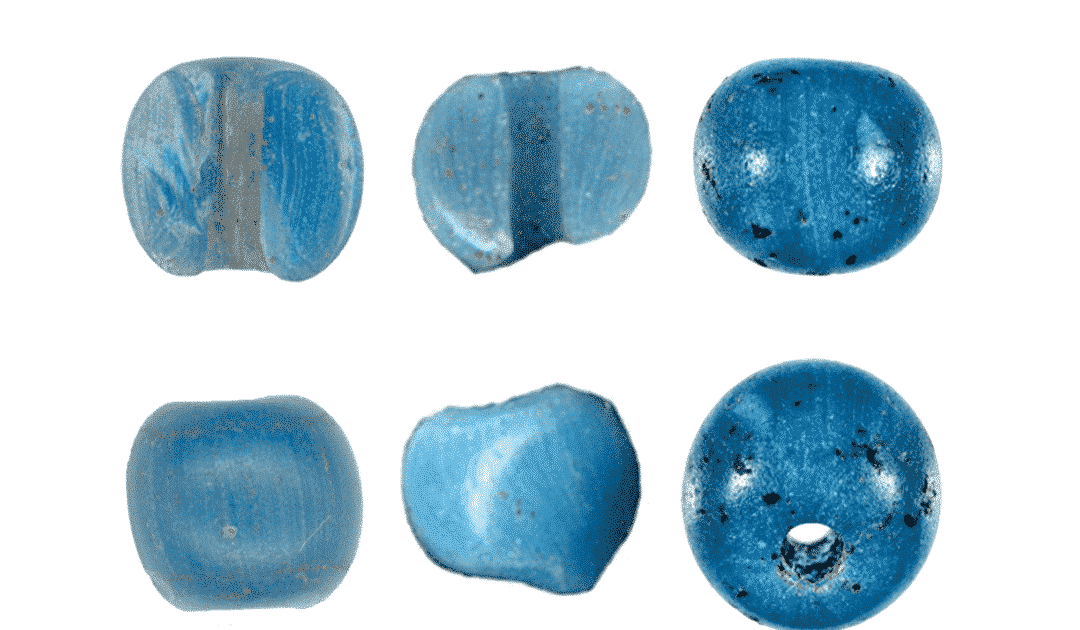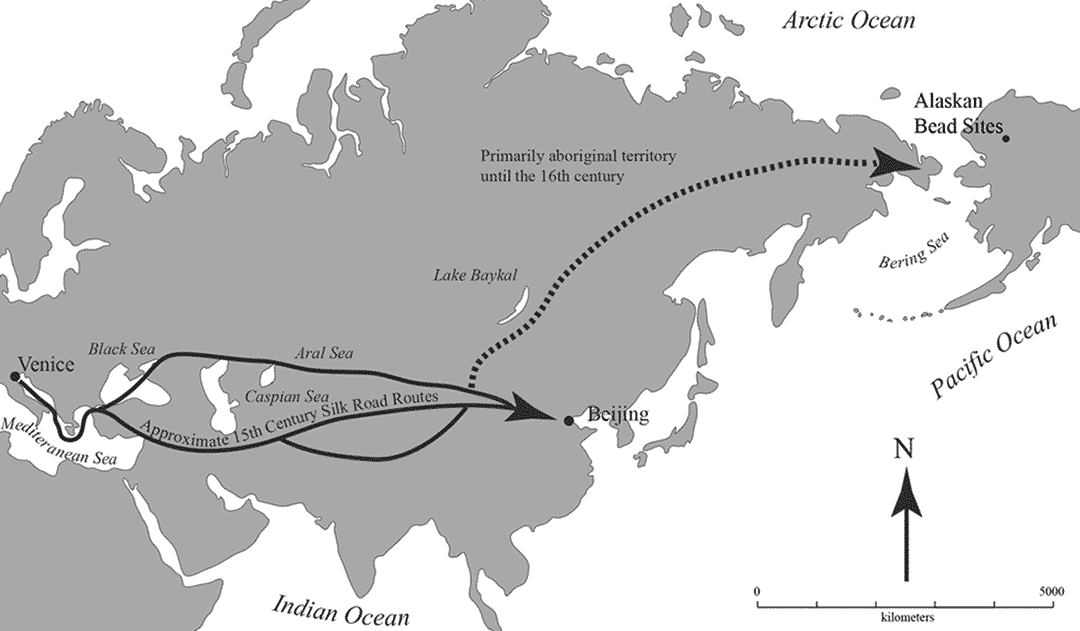
Christopher Columbus is credited with discovering North America by sea in 1492, but blue glass beads from Venice apparently reached Arctic Alaska decades before him. American archaeologists found the blueberry-sized beads during digs in the Brooks Range of northern Alaska and dated their discovery to the 15th century. The beads may thus be the first European objects to reach North America.
During digs in 2004 and 2005, the excavation team found three beads along with plant fibers and jewelry made of metal at Punyik Point which has great significance from an archaeological perspective. Today Punyik Point is uninhabited, but in the past it was a seasonal camp used by generations of inland inuit. Ancient trade routes passed by here and it was probably also a good place to hunt caribou. Archaeologists have been digging at this site for a long time. Back in the 1950s and 1960s, William Irving of the University of Wisconsin found two of these glass beads at Punyik Point.
At least ten of the small blue beads with a hole through the center, made in Venice, Italy, survived the centuries largely unscathed in the cold tundra floor at three different locations. Archaeologists Mike Kunz and Robin Mills recently unlocked the mystery of the beads in a study published in the journal

The plant fibers wrapped around one of the metal rings found in close proximity to the beads allowed the two archaeologists to determine their age quite accurately using accelerator mass spectrometry. The carbon dating revealed that the beads must have arrived at Punyik Point between 1440 and 1480, years before Columbus even thought about his voyage. A result that stunned the two archaeologists.
“We almost fell over backwards. It came back saying (the plant was alive at) some time during the 1400s. It was like, wow!”
Mike Kunz, archaeologist at the University of Fairbanks, Alaska
With this result, later confirmed by similar finds at two other sites in the Alaskan Arctic, archaeologists knew these pea-sized objects told a great story. “This was the earliest that indubitably European materials show up in the New World by overland transport,” Kunz said.
By studying the history of glass bead making in Venice, they figured that the beads must have come from the lagoon city famous for its glass art. But how did the beads, which have not been found at any excavation site west of the Rocky Mountains, get from the canals of Venice halfway around the globe to a plateau in the Brooks Range?
In the 1400s, artisans in the city state of Venice traded with people all over Asia, and pearls were valuable trade goods at the time, used as currency. The authors therefore suggest that the “trade pearls” may have traveled eastward to China in a horse-drawn cart along the Silk Road. From there, “these early Venetian beads found their way into the aboriginal hinterlands, with some moving to the Russian Far East,” they write in their current study.

After this great voyage, a trader might have stowed the pearls in his kayak on the western shore of the Bering Sea, as described in the press release. He then dipped his paddle and set off for the New World, now Alaska. Crossing the Bering Strait at its narrowest point, he had to navigate some 84 kilometers of open ocean.
Kunz and Mills believe the beads probably arrived at an ancient trading center called Shashalik, north of present-day Kotzebue. From there they were carried by people on foot, perhaps with a few dogs, deep into the Brooks Range.
At Punyik Point, someone may have strung the exotic blue beads on a necklace that they lost or left behind when they moved on. The tiny blue spheres then rested for centuries at the entrance to an underground house north of the Arctic Circle, waiting to be found.
Julia Hager, PolarJournal






In the US and Canada, lead poisoning used to be a serious problem with waterfowl because they gobbled up lead shot from the bottoms of ponds along with their food. At least one may have carried it north on its spring migration. Pierced lead shot was found on Southampton Island in northern Hudson Bay, in Sadlermiut house ruins that predated any known contact with outsiders (by Dr. Susan Rowley). Could a goose have swallowed a necklace from the bottom of a pond and then migrated northwest across the Bering Strait? I am reminded of the Sherlock Holmes story about a domestic goose that swallowed a large gemstone (carbuncle). It was also blue.
Birds usually do not swallow blue things. That is why the rat poison baits used in South Georgia, New Zealand and other places are blue. Additionally, as there were several beads, any animal wouold have swallowed an entire bracelet or necklace, which is highly improbable. But good thinking, nonetheless. Thank you for sharing with us and for reading our article.
Fascinating account. My parents lived in Nome, Alaska in the 30’s through the 50’s. During this time they often heard stories from the native people about their travels in both directions between Siberia and villages around Nome. The claim was they were visiting relatives or seeking brides. No one then considered this exceptional.
I continue to read how modern scholars consider the straights impassable. Do they consider how much of this waterway freezes up from time to time? Or how far the Inuit ranged in skin boats?
Thank you for your contribution. What seems normal for one side isn’t necessarily normal for another side. Often, we do look at things only from our perspective and are astonished by the achievements by native peoples, simply because we compare it with our achievements and know how much was involved in this achievement (technically, financially etc.). In this case, considering that people crossed the strait in Umiaks or on the ice is an achievement in itself, no matter the time or the culture looking at it. But for the Inuit-Yupik, it was necessary and therefore had to be done.
Was the source of the copper used in the bangles found with the glass beads examined? That might shed light on the origin of the fabricator’s ‘parts’ kit. The origin of the ores used to make copper items, also useful in studying bronze items, would be informative.
The best source I could find on short notice was at gmatclub.com/forum/the-determination-of-the-sources-of-copper-ore-used-in-the-manufacture-269159.html
Wonderful information showing that ‘true’ science is not dead.
Thank you very much for your contribution and your thoughts. As far as we know, the scientists only examined the beads. But your suggestion might add some more information on the origin or the route the beads had taken more than 500 years ago.
We had the iron artifacts and copper rings, along with the glass beads, examined by experts in their respective fields. The copper artifacts are all made by aboriginal (not smelting) techniques. Unfortunately, their constituent elements cannot be pinpointed to source like other types of resources can (at least yet). The iron pendants WERE smelted, and likely also derived from the Old World. Similarly, they cannot be sourced to location. They are likely Chinese, but that is a guess. Best, Robin Mills
Greenland two Viking settlements did have interactions with the Inuit population and traded with them. And those people traveled and traded with their kin. That is another possible route…
Thank your for your contribution. The Norse settlement on Greenland and Canada had disappeared before the manufacturing of those glass beads. Therefore, this route is rather unlikely. However, it may be that earlier goods had reached the Canadian Arctic or even Alaskan Arctic on this route and were just not found yet.
We examined all known published archaeological datasets dating to this general timeframe, from excavations across the Canadian Arctic. The type of glass beads found at the three Alaskan sites are not found anywhere across northern North America. They ARE found in southern Ontario, which (along with those found in neighboring New York state, and other places along the East Coast of N Amer) date to later time periods. Not the 15th century. Best, Robin Mills
Is it possible that the beads were made in China?
Thank you for the question. According to the scientists, the nature of the manufactured glass beads was Venetian.
The glass beads are of a distinctive type (Type IIa40, Kidd and Kidd 1970) of drawn bead that is easily distinguished from Chinese beads made in this timeframe. Best, Robin Mills
Very interesting.
However, I do wonder just how accurate the dating methods are. The delta range seems highly constricted.
Nonetheless – the reality is that even if the beads arrived 50 years after Columbus “discovered” the New World, it would still indicate non-European contact with the Americas.
Or would it? Could not have Icelandic visitors have brought Venetian products to the New World?
Thank you for your contribution and for following this highly interesting article.
Considering the dating method, there always is a specific uncertainty. However, in this case, it seems quite accurate and specific. But as you point out: Columbus had only reached the Carribean part of the US, not Alaska. And despite the speed with which the colonialization of the Americas had started, it is highly unlikely that Ventian goods had made it that far north before the late 16th century.
Concerning your question on the possibility of Norse traders bringing such goods to the American Natives: The Norse settlements were either abandoned or had disappeared around the beginning of the 15th century in Iceland. And the ones on American soil even earlier. Also, using glass beads as trading goods was more of a Southern and Middle European style than Norse style. Thus, it can be ruled out to have been brought by Norse traders or via the Western route that far east.
Thank you again for your this.